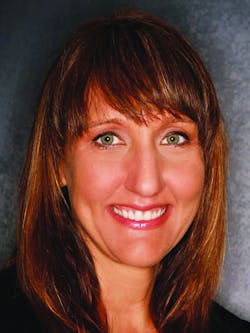Not every healthcare organization’s consolidated service center, warehouse or storeroom can be rigged to function as a teched-out assembly line, anchored with automated guided vehicles, conveyor belts, interoperative software, mobile robots and robotic arms moving stuff around as supply chain staffers, sporting eyewear with heads-up display capabilities, wielding smart phones and wearing swanky wrist computers, calmly traverse the floor.
Those who may be outfitted with some of the latest tools and toys can juggle multiple demands and emergency needs with aplomb, efficiency, and effectiveness because they already know about backorders and anticipated clinical procedure requests as they’re plugged into production schedules outside the organization and surgical schedules inside. They’re connected to artificial intelligence (AI), blockchain, crosslinked item master-to-charge data master systems, enterprise resource planning (ERP) modules, radiofrequency identification (RFID), real-time location systems (RTLS), robotic process automation (RPA) or other automation technologies.
Few may be more tech-decked than most, but many yearn to adopt and implement as much as possible, hinging on budgets and business cases provided, as well as the skills – latent and learned – that staffers possess, supply chain tech experts indicate.
Healthcare organizations, by and large, rely on RTLS and other supply chain automation tools to manage, track, and trace three primary areas within and without supply chain: Process and workflow, product and service usage and the safety of patients, staff and visitors on campus or within a facility.
Where some might be able to construct new or retrofit existing buildings fully equipped with the latest technology applications, others approach improvements on an incremental basis, adding technological capabilities under a longer-term plan as resources allow, according to supply chain tech experts.
Based on the diversity of circumstances and available resources, healthcare facilities appeared to be on a tech-adoption trajectory until the global COVID-19 pandemic emerged in early 2020 in the United States, and disrupted worldwide supply channels for much of the next three years.
Although some question the rate of operational recovery from the seemingly receding pandemic, others widely acknowledge that facilities are pumping the brakes on implementing much of the tech that tickled fancies and tempted eyes for the last decade or so. Instead, they’re returning to the fundamentals, dependent on facility size and location, limited resources and speed to results.
Basic package deal
At this point, slowing the momentum of technological implementation progress may be beneficial, experts tell Healthcare Purchasing News.
“As with any investment in technology, healthcare organizations must start with the business objective or challenge they are trying to solve and then pick the best technology to address that need,” said Keith Lohkamp, senior director, Industry Strategy, Workday. “I do believe, however, that most organizations need to start by laying a strong foundation by either investing in ERP technology or, at a minimum, MMIS technology, to create a unified view and set of processes for inventory and procurement. And frankly, almost every other technology [on the ‘supply chain automation technology’ list on page XX (which is Sidebar 1 with Chart)] is either dependent on or would benefit from having this foundation because of the underlying process or the need for data.”Lohkamp further contends that many of these technologies may even be included in that foundational investment. Workday Supply Chain Management users, for example, already have the option to use mobile devices and barcode scanning, he explains. Further, built-in AI features for Natural Language processes allow for the use of company chatbot Workday Assistant to check on the status of requisitions, while other AI/ML functionalities automate transactions or make recommendations during requisition creation. Processes can be integrated into a WMS or a carousel to support additional options for managing inventory within and outside the hospital, he adds.
1. Recognizing the shared challenges across the healthcare landscape and spanning all types of institutions
2. Focusing on where they are at along the technology-adoption journey and if they have the foundation – people, process, and foundational technologies – in place to support more advanced tech solutions.
“Building the foundation – ORIS, ERP, MMIS – is key before layering on other tech solutions to support supply chain automation,” Wicks noted. “In addition, when health systems are looking to invest in more advanced clinical supply chain technologies, focusing on partners that offer one platform with flexibility on integration capabilities, as well as usage of different data capture devices to support the institution’s different needs (e.g., barcode, RFID, Kanban, mobile, etc.), will provide institutions the necessary enterprise visibility across their institution to deliver on improved financial performance, improve staff efficiency, and ultimately, enhanced patient safety.”
“Most organizations' lowest-hanging fruit is ongoing metadata management required to gather meaningful insights,” Amell said. “Those insights would inform what areas have the largest opportunities, and then would warrant investigation of the proposed technologies.
“I personally think there is a natural progression of improvement and growth when it comes to buying and utilizing technology,” she continued. “Organizations, regardless of size or scope of service, need to understand their current state and put those foundational technologies in place like an MMIS, ERP or WMS. Some of these technologies are in such early adopter phases that until they are successfully used in industry over a period of time they are likely not worth the investment to the majority of organizations.” Amell points to augmented reality/virtual reality (AR/VR) products as examples, especially if organizations are not using current technologies with proven results like mobile technology, barcoding and RFID/RTLS, she added.
"There needs to be a solid foundation from which complicated services can be launched,” he observed. “They will need to invest in building this foundation first. Once the foundation is built and tested properly, the sky is the limit in deploying cutting-edge technology solutions.
Assuming that a health system already has an ERP and EHR/EMR system in place, then Muttin urges an organization to invest in MMIS and RFID, as well as demand-management/predictive-analytics software. “This demand management should go beyond the traditional use case for demand management and include the integration of preference card/bill of material information to predict the demand and hence, inventory management,” he added.
But Muttin recognizes the looming storm clouds this year.
“Health systems are facing significant headwinds, and this situation will likely continue for the rest of 2023,” he forecasted. “Supply chain leadership will be required to find cost savings in the next six-to-nine months. Hence, they will need to concentrate more on ‘blocking and tackling.’ This requires investing in solutions that will deliver the results.”
While technologies such as blockchain, AI, wearables, augmented reality, etc., likely will have a huge role to play in transforming the supply chain landscape, according to Muttin, implementing them will require significant new resources, such as dollars and talent. “CFOs are unwilling to sign off on such investments at the current time, [so] it’s prudent for supply chain to invest in technologies that are guaranteed to generate results in a six-to-nine-month period,” he added.
Resource limitations
One of the major impediments to investigating, investing in, and implementing supply chain automation technology hinges on available resources – whether that amounts to budgets, cash-on-hand, credit for financing or labor, talent, and training.
Cardinal WaveMark’s Wicks offers a panoramic picture of future operations that technology will impact.
“All healthcare providers, regardless of their size, are facing similar challenges: Labor challenges with shortages expecting to continue through 2025, supply chain disruptions leading to lower-than-average fill rates into the 80%-90% [range], and increased revenue and cost pressures,” he told HPN. “Therefore, it’s more important to assess where you are along the technology-adoption journey to ensure you’ve invested first in foundational elements to support the layering of more advanced technology solutions.”
Foundationally, healthcare organizations should pursue ERP, MMIS and ORIS implementation first and foremost to ensure maximum utilization, according to Wicks. “These systems are core to capturing the key data elements of the health system related to patient information and resource planning,” he said. “These are often necessary integration components for other advanced automated supply chain technologies.
“Once these components are in place and functioning, more advanced solutions can be layered in to offer enhanced product visibility across the enterprise, and provide the data and insights to support strategic decision-making and bring together the clinical and supply- chain teams,” Wicks continued. “Even for an organization with limited resources, selecting a technology partner that offers flexibility in integration with multiple data capture technologies – barcode, RFID, Kanban, automated cabinets, etc. – as well as integration capability with your foundational tech systems – ERPs and EMRs – will offer the ability to support your organization’s needs today and adapt to more advanced solutions as your needs change.”
Wicks recommends that any technology partner should offer three elements:
1. Flexibility with the type of data capture technologies to meet your different clinical supply chain needs now, as well as in the future
2. Proven integration with existing technologies
3. Roadmap to grow into the new technologies
“Too often, technology is implemented as a ‘silver bullet’ without a clear understanding of the problem it’s being asked to solve or a clear set of success metrics,” Doner noted. “As a result, the impact from the latest technology rarely aligns to the return-on-investment goals or the end users’ expectations. Taking a data-first approach both informs your decisions about technology investment, as well as lays a strong foundation for building an agnostic technology ecosystem.”
Doner acknowledges the factors that influence technology investment decisions, including size, geography, and supply chain strategy.
“Every technology has its purpose,” he said. “However, that does not mean every technology is the right fit for every health system. Your supply chain strategy will determine how you need to predict and capture demand signals, manage inventory, service your customers, and control costs to deliver the right clinical, operational, and financial outcomes.”
Ceasing milk runs
Scott Hondros, MHA, SCPM, vice president, Professional Services, CenTrak Inc.,recognizes the challenges, too.“Due to the pandemic, the last few years have caused significant disruption and constraint of budgets, manpower, and resources all throughout healthcare facilities, from the bedside to the back office,” he observed. “As such, healthcare professionals and administrative employees are asked to do more with less. Providing the necessary support is key to achieving high-quality patient care, staff satisfaction, and overall retention, along with increasing an organization’s bottom line.”
As a result, Hondros firmly recommends RTLS, RFID and RPA as providing the “support, visibility, and return on investment (ROI)” for a “near-immediate positive impact” for professionals and their organizations.
“Through enterprise visibility, healthcare professionals can gain better insights into the needs and safety of their patients and coworkers, the location of required mobile medical equipment, and the status of supplies,” he said. “By being able to remotely visualize what assets are in a given location, staff members can be saved from making a ‘milk run’ to check on items, and can reallocate that time back to patient care.”
The absence of technology can generate a deleterious outcome, according to Hondros.
“Manual documentation is often ineffective, time-consuming, and can be inaccurate due to human error,” he said. “In real-time, RTLS shows what is in each location, the status of those items, and if the medical equipment is soiled, in-use, being repaired or available. Predictive analytics then informs staff members of what equipment is or will be needed in specific areas, allowing teams to look ahead and properly prepare based on the anticipated demand to meet patient needs. Alternatively, instead of waiting for an order to be put in, automated offerings can create an order to replenish necessary items once an asset or item has been removed from its current location. This ensures that clinical staff can have what they need before they need it.
“Monitoring expensive, mobile medical equipment is best achieved with RTLS, while RFID is best for consumable goods,” Hondros added.
Managing critical inventory with a measured approach to process investment can be complex, particularly if organizations seek the right balance to satisfy their mission and want to design relevant solutions, according to David Lefkowitz, director of Market Strategy, Terso Solutions.
“This is not a ‘one-size-fits-all’ approach, and it’s imperative that individual solutions can be designed and implemented to exceed the needs of the hospital and fit within budgetary constraints of the organization,” he said. “It’s always a balancing act, but we utilize a sound approach that ultimately yields great things for our customers.”
Organizations should start with their end game in mind, Lefkowitz says. “For example, are you looking to better manage orthopedic implants, cardiac catheters and stents, tissue and biologics, or do you want visibility and automation for your med/surg inventory? Once this is understood, then there are multiple RAIN RFID hardware – open and closed systems – in conjunction with our partners’ cloud-based software options – that can be utilized and tailored to meet specific budgetary constraints.
“When evaluating RTLS technologies, it’s important to understand the organizational goals and then balance it with cost, reliability, accuracy and timeline of getting the solution up and running,” Lefkowitz continued. “As RTLS continues to evolve, it makes sense to evaluate newer technologies, such as WiFi, UWB, BLE, and others. Once your supply chain challenges are fully understood, then you can move forward with the right technology and develop the right solution for your organization.”
“We’ve found that it works well to start small and then expand into adjacent areas as we prove our value to the hospital system,” he said. “So, if you start by managing tissue and biologics, and clinicians and Materials Management staff are happy with the outcome, then expanding into managing other clinical inventory like the Cath Lab space is fairly easy and welcomed by the hospital staff. In combination with great channel partners, we like to prove ourselves along the way and this type of approach allows hospitals to recognize our value and expand our technology as they see fit.”
Back to basics for supply chain automation technologies as pandemic ebbs
Healthcare organizations must learn to ‘walk before they run,’ hesitate on ‘bright, shiny objects’
What are the key automation technologies that will drive supply chain operations within hospitals, regardless of facility location, size or type? Supply chain technology experts center on 10 that represent the more practical and less fantastical as the world slides into a post-pandemic industry revision.
1. Enterprise Resource Planning (ERP) system (interconnected modules that link administrative to clinical to financial to operational throughout the enterprise/organization)
2. Materials Management Information System (MMIS) (for contracting, distribution, inventory, ordering, etc.)
3. Mobile devices/technology (e.g., multifunctional smartphones for operational tasks)
4. Radiofrequency identification (RFID)
5. Barcoding/QR coding
6. Demand-management/predictive-analytics software (for tracking deliveries to the dock and dispensing to the clinical areas)
7. Warehouse Management System (WMS)(for footprints larger than storerooms)
8. Internet of Things (IoT)/Machine-to-machine (M2M) interoperability
9. Robotic Process Automation (RPA) (including advanced dashboards and using “bots” to accomplish basic, mundane and routine tasks and automatic reorder points)
10. Real-time location systems (RTLS)
While experts regard the previous 10 as “must-haves” going forward, they group the rest of the list as “nice-to-haves.”
· Artificial intelligence (AI)
· Eyewear equipped with augmented reality (AR) (e.g., for directions, instructions, locating, mapping, teaching, training, etc.), and/or with virtual reality (VR) (e.g., for demonstrations, designing, in-service training and education, etc.)
· Automated guided vehicles (AGVs) (including remote-control tugs and roving delivery carts)
· Automated product dispensaries (e.g., closed cabinetry/carts, open/weight-based cabinetry/carts)
· Blockchain
· Carousels
· Drones (e.g., for aerial views of high shelves and short-range transport to various buildings on campus)
· Robotics (including “co”botic arms, exoskeleton harnesses, mobile robots for deliveries, disinfection/sterilization, etc.)
· Wearable computing/sensors (e.g., wearable and wireless sensors, watches, wristbands, badges, pins, neckware)
Tools over toys
Instead of filling a toy chest full of the latest tools, Marlin Doner, vice president, Data Analytics and Product Strategy, Prodigo Solutions, advocates for something more structurally driven.
“Rather than focus on the latest ‘bright shiny object’ that technology vendors often package themselves as, your focus should be to build your technology ecosystem,” Doner insisted. “With the move toward cloud computing, modernization strategies are moving away from the ERP ‘system’ as the monolithic center of the information management universe to a virtual collection of services that make up the ERP ‘ecosystem.’ These purpose-built microservices [apps] deliver specific business capabilities and are interconnected through well-defined APIs within the ecosystem.
“Architecting your supply chain through a microservice strategy keeps your technology agnostic, while allowing you to deliver best-of-breed capabilities inside a modern user experience [mobile, desktop, API] that is served up on a harmonized data platform,” Doner continued. “With this design, you can rapidly scale technology adoption while maintaining independence from the individual technologies that you choose to deploy, while also gaining visibility to the data required to monitor the impact you hope to achieve.”
Arnold Chazal, CEO and co-founder, VUEMED, cautions against the allure of tech flashes that can lead to process-improvement blindness.
“Many technologies in this list are exciting new developments in the realm of solutions that can apply to healthcare, but many are quite sophisticated ‘bright shiny objects’ that are more likely to distract, rather than assist,” he said. “The focus must be, first and foremost, on bringing healthcare supply chain and inventory management to the level of technology adoption that other industries have already achieved, having understood long ago the strategic value of using modern technologies to optimize their supply chain.”
Chazal contends that AI, AR/VR-equipped eyewear, AGVs, drones, RPA, robotics, and wearable computing/sensors represent “cutting-edge technologies that do not address the fundamental issues of supply chain and inventory management in healthcare today, where technologies – if they exist at all – and processes are often archaic and barely capable of performing. I do not believe that the great majority of hospitals of any size or location will be in a position – in terms of competency, infrastructure and/or finance – to leapfrog to sexier technologies today or in the immediate future while the basics are still elusive and not in place. They need to learn to walk before they can run.”
Consequently, Chazal foresees a cost-effective pathway toward technology investment and implementation that can lead to efficient outcomes.
“The biggest bang for the buck is going to come from managing the inventory as part of the supply chain which, in so many cases, is often done manually, using inadequate and fragmented methods and technologies (if any) and where the stakes are very high in terms of financial impact (shrinkage, cost avoidance, revenue capture) and the core mission of quality and safety of patient care (expiration and recall management, backorders handling, etc.),” he said. “As a result, I think that barcoding and RFID are the technologies that can provide the quickest and highest benefits across the board and with a substantial ROI. Inventory management and improvements to the supply chain are the low-hanging fruits in the majority of hospitals in terms of opportunity, size, readiness, and impact on the rest of the organization.”
Plan in phases
When it comes to assessing and implementing technology, quantity gives way to quality in terms of applications, according to supply chain technology experts.
“The goal of any technology is to standardize, streamline, and automate business process, ultimately reducing an FTE’s [full-time equivalent’s] steps to complete a task or perform their work,” said Melissa Amell, senior director, Healthcare Strategy, Supply Chain, Infor.
Whether an organization has limited resources or looks to make the biggest impact on operations to include improving the visibility of data, maximize efficiencies of core supply chain business operations and automating and reducing manual intervention in those processes, Amell recommends the following three technologies “at a bare minimum” as foundational:
· ERP (with MMIS functionality contained within to support Supply Chain Operations) or MMIS (on its own)
· Mobile devices/technology
· Barcoding/QR coding
Specific options depend on the scope and maturity of the supply chain organization, as well as what technology is already in place, according to Amell. “The more mature organizations that have a solid technology foundation would be looking at some of the more advanced functionality like AI, RPA, and demand-planning and predictive-analytics software to take their operations to the next level,” she added.
Healthcare systems that seek to assist staff quickly with patient care, improve morale, and increase revenue following the impacts of the pandemic should pursue three technologies, recommends Scott Hondros, MHA, SCPM, vice president of Professional Services, CenTrak Inc. They are ERP system integration, RFID and/or RTLS.
“These technologies provide significant ROI, and will achieve quicker results in both the short and long term to assist healthcare staff and facility leadership in reaching their goals,” he indicated. “These solutions can provide complete enterprise visibility, and by integrating an ERP with other solutions like RTLS or the Computerized Maintenance Management System (CMMS), the system can share equipment quantities and data that are automatically updated in real-time. This level of insight is crucial to benefit the supply chain, increase staff efficiency, ensure patients receive care in a timely manner, and make a positive and significant impact on the bottom line.”
Hondros acknowledges that it often isn’t cost-effective or practical to gain visibility into every tool or mobile medical equipment all at once. “To guarantee a better price for these technologies, decision-makers can prioritize and narrow down the locations that require deeper insight,” he recommended. “This will not paint a full picture of enterprise visibility, but it will provide a lower cost to entry, and showcase the value of implementing the technology. In the end, ROI and stakeholder buy-in will benefit, and future expansion to other areas of the facility will be easily justified.”
Finally, Hondros outlines a workable blueprint for decision-making.
1. Select the top five assets the team is looking to locate and secure consensus from departments such as the equipment distribution, supply chain, nursing, etc.
2. Make sure that the collective group agrees that the selected equipment focuses on items in the highest demand, ones that can be a struggle to keep it in stock, and constantly run low or have an adverse impact on patient care.
3. This approach enables facilities to focus on the clinical assets and locations that make the most sense for a “Phase 1,” and outfit the key areas in the equipment workflow at a lower price point.
4. This also allows the implementation and use cases to be up and running quicker and, as teams recognize the value, the solutions can be expanded in a seamless manner to the larger organization as desired in the future.
5. Facility teams can also talk with their solutions partner and consider if they require RTLS or RFID tags based on the passive or active status of the items in which they wish to have visibility.
Scoping out supply chain automation technology by facility demographics, type
How much does it matter whether your healthcare organization represents a larger or smaller facility, or multiple facilities, near a big city or out in the country or even across county or state lines? And with healthcare services extending beyond acute-care hospital walls and into more remote-care facilities, such as ambulatory surgery centers, clinics, physician offices, retail outlets and even patient homes, how might technology implementation impact clinical service expansion.
Investment in specific technologies is not as much about organization size and location as it is about where they are in their technology-adoption journey and the appropriate infrastructure and resources in place to support more advanced technology solutions,” said Nathan Wicks, vice president, Commercial Technologies and Engineering, Cardinal Health WaveMark Solutions. “Therefore, it’s not a ‘one-size-fits-all’ kind of approach to which technologies are best suited for the different types of institutions, as their adoption of technology can vary widely.”
Three other supply chain technology experts remain mixed, insisting that any standardized, utilitarian approach likely would face challenges.
Larger, urban hospital and non-hospital facilities
“Demand-management, predictive-analytics software, and Robotic Process Automation (RPA) make the most sense within larger hospitals and non-hospital facilities. These facilities have a larger number of people and a greater range of locations throughout the enterprise. The complexity of tasks and the variety of people crossing paths with equipment are more significant, and supply chain managers are responsible for knowing what is in each area, when it will be required, and when it will need to be replenished.
“Predictive analytics and RPA provide more visibility, which is vital for efficiency in larger facilities. For these spaces, key areas like the supply room and other storage options around the facility are spread out, meaning more equipment changeover, which requires the supply- chain team to cover a larger geographical space for inventory checks. In larger facilities, there’s also a greater ability to leverage automation aspects with these tools to accomplish more basic, routine tasks.”
Scott Hondros, MHA, SCPM, vice president of Professional Services, CenTrak Inc.
“In larger, urban hospitals and large hospital systems, it’s imperative to have visibility and control of your high-dollar PPI [physician preference items] and med/surg inventory across the IDN. Not only within individual supply rooms in a single facility, but across many facilities and system-wide. This is not an easy task but can be accomplished through a layered approach using a combination of RAIN RFID technology (open and closed architecture) coupled with cloud-based inventory management software. Every hospital is unique and a tailored approach using the right technology for managing the right type of inventory is vital. It all starts with understanding the needs of the hospital system. Once priorities are understood and an assessment has been performed, then the right solution can be developed and put in place.
“At Terso, we work with great channel partners that combine leading inventory-management software in the perioperative space with our RAIN RFID hardware to enable hospitals and larger health systems to ultimately gain better control, visibility, and efficiency with their clinical inventory. Not only does this technology allow for greater visibility and control, but perhaps more importantly, allows clinicians to focus on patient care and not on inventory-management tasks. In the current healthcare environment where labor shortages are a real issue, supply chain automation through technology enables greater productivity and doing more with fewer people. This has never been more important than now.
“Our solutions utilize IoT sensors in a variety of ways, combined with cloud-based software to automate inventory-management processes throughout hospitals and hospital systems. We advocate a ‘walk before you run’ approach and don’t prescribe a solution before we fully understand the needs of the hospital system and the desired outcome. Depending on needs and budgetary constraints, the right solution can be designed and implemented in a straightforward, timely, and cost-effective manner.”
David Lefkowitz, director of Market Strategy, Terso Solutions
“MMIS and ERP systems are essential tools for managing the basics of supply chain and inventory management in any size organization. But the larger the organization, the more supplies, vendors, and SKUs are needed, thus making these systems even more essential.
“Both barcoding and RFID technologies suit large, urban hospitals because of the sheer volume and diversity of supplies being managed, the great number of storage locations, and the fact that it is challenging to ensure consistency in supplies management when so many users ‘touch’ the supplies throughout their lifecycle. As a result, automating the management of supplies is vital for keeping track of medical supplies and devices in a manner that prevents mistakes and mitigates risks such as expirations and recalls. Barcode scanning and RFID are essential automated systems for managing supplies from the point of entry or receipt to the point of care.
“Demand-management/predictive-analytics software could be a nice addition for optimizing the ordering of supplies, as well as the on-hand inventory that can vary greatly with the seasons and various cycles in patient volume and can fluctuate or be affected by back-orders or shortages.”
Arnold Chazal, CEO and co-founder, VUEMED
Mid-sized suburban hospital and non-hospital facilities
“In mid-sized facilities, predictive-analytics software and RPA/automatic reorders remain crucial. These facilities aren’t as large, but it remains essential that employees have visibility into the deliveries entering the dock and know where essential medical equipment and supplies are located throughout its journey to clinical areas. Through enhanced visibility, employees at these facilities can save significant quantifiable time, ensure each department has the equipment required, and have accurate knowledge of supply status. These solutions enable a smoother, more accurate process, which is especially beneficial when facilities are short-staffed and resource-constrained.”
Scott Hondros, MHA, SCPM, vice president of Professional Services, CenTrak Inc.
“As Terso advocates taking an individualized approach depending on the needs and budgetary constraints of the organization, the size of the hospital is not a limiting factor. We recommend the same initial process regardless of size, and would start by understanding the needs and priorities of the organization and then move forward with a walk-through and assessment of current supply chain processes. At that point, we’ll work with our partners to make preliminary recommendations and scope out the project, cost, and timeline.
“Terso has been in this space for almost two decades and we pride ourselves on doing what’s right for the customer. In conjunction with our channel partners, we can bring a great deal of value by automating the clinical supply chain at facilities large or small. So again, it just depends on the needs and priorities of the customer, and we’ll endeavor to design and implement solutions that meet these parameters and exceed expectations.”
David Lefkowitz, director of Market Strategy, Terso Solutions
“Same as [for larger hospitals], except that demand-management software may not be as critical and barcoding may be preferred over RFID because everything is typically easier to manage at a smaller scale and with fewer users involved. Mobile devices could be a good, more flexible substitute, especially when it comes to inventory management and auditing and is less costly than RFID.”
Arnold Chazal, CEO and co-founder, VUEMED
Smaller, rural hospital and non-hospital facilities
“Predictive analytics aren’t as beneficial or cost-effective in smaller facilities as they are when applied to mid-sized and large facilities. Smaller, rural hospitals and non-hospital facilities are unique and therefore, require unique solutions. The layouts of these facilities aren’t as complex as in larger facilities, and there aren’t as many people moving in and around the building. When considering the best technology for the environment, daily needs, and the most cost-effective option, I recommend passing on predictive analytics and pursuing mobile devices, like smartphones. Mobile equipment allows staff to take it on the go and conduct an asset status analysis, while physically in the storage location to gain the most accurate and real-time update on equipment and to better use the facility’s budget.”
Scott Hondros, MHA, SCPM, vice president of Professional Services, CenTrak Inc.
“I would argue that automation is just as important at small, rural hospitals as it is at mid-sized or even larger hospital systems. While the scale may be different, the need for automation is just as important. In many smaller hospitals, much of the materials management is often done manually. The pandemic exposed many of the weaknesses of the healthcare supply chain and I would argue that many smaller, rural hospitals have been impacted more than others. Not only is it tougher to manage clinical and non-clinical products manually, but many hospitals are also having to do this with fewer people as labor shortages continue to affect hospitals nationally.
“With this in mind, technology can help bring efficiencies and automate the process. Not surprisingly, Terso recommends the same initial method regardless of size of hospital and would start by understanding the needs and priorities of the organization, and then move forward with a walk-through and assessment of current supply chain processes. Then we can make preliminary recommendations and scope out the project, cost, and timeline.”
David Lefkowitz, director of Market Strategy, Terso Solutions
“Same as above, with an emphasis on the value of barcoding and mobile device technologies because they are excellent automation tools that perform well in more controlled, smaller environments that typically have better oversight because fewer users are involved in the supply chain process. In these smaller, rural settings, staying consistent doesn’t require the highest degree of automation that both RFID and RTLS provide.”
Arnold Chazal, CEO and co-founder, VUEMED
Remote care facilities (e.g., ASCs, clinics, physician offices/practices, retail outlets)
“From my experience, remote-care facilities are similar to large and medium healthcare buildings, which means demand-management/predictive-analytics software and RPA make the most sense. While remote-care facilities often have small storage spaces, there are usually multiple locations spread across a large geographic footprint. Remote-care facilities can benefit the most from an implementation of Real-Time Location Systems (RTLS) or Radiofrequency Identification (RFID) that remotely informs a staff-facing dashboard or analytics tools about real-time inventory and what replenishment should look like without a staff member having to physically visit each supply area. These systems will best audit what’s in the storage rooms, what is still needed, and what is being restocked, freeing up staff members to focus on their patients.”
Scott Hondros, MHA, SCPM, vice president of Professional Services, CenTrak Inc.
“In remote-care facilities, managing inventory can be a very manual and time-consuming process. Using the right software and automated inventory-management technology, such as RAIN RFID, ASCs can realize real-time visibility to the consignment inventory at all ASCs from anywhere. This information is then accessible to sales reps, hospital administrators, and ASC staff. One can ensure necessary items for procedures are in inventory, optimize the inventory levels at each ASC, manage expiry of products, and automate replenishment. While the scale and needs may be specialized, remote-care facilities can ultimately improve supply chain efficiencies through the right technology.”
David Lefkowitz, director of Market Strategy, Terso Solutions
“It is difficult to justify ERP and MMIS systems when the scale is so small, although a system of some sort would be helpful. Many such facilities manage with more basic Microsoft-based tools or less complex software-management tools. Again, barcoding may be the technology that is best adapted to provide the highest level of control in inventory management and supply chain at the lowest cost, with ease of use and a low-level investment.”
Arnold Chazal, CEO and co-founder, VUEMED
Decision support for supply chain technology assessment
Clean data vs. access to single source of truth should be top-of-mind
Just as the case in the Sterile Processing and Distribution (SPD) department where science, standards, and regulations dictate that a device not cleaned properly also cannot be disinfected or sterilized effectively, in Supply Chain and other departments, data that aren’t accurate and clean should not be shared or transmitted for analysis and trends.
One of the underlying caveats of investing in Real-Time Location Systems (RTLS) and other supply chain automation technologies involves the accuracy of an organization’s data in such systems as the item master (IM) and charge data master/chargemaster (CDM).
Supply chain technology experts, by and large, agree that data should be clean and correct before investing in basic and advanced automation technology, but that gaining access to a single source of truth may be enough to justify and not delay supply chain technology investment.
“Yes, the cleaner the data, the better results with the technology. Layering on technology without cleaning the data can set the health system up for disappointment and not able to achieve goals.
“Having clean item master data is critical – and selecting the proper technology and vendor can help with the cleanup. With Cardinal Health WaveMark Solutions, this is a key success pillar for us whenever we onboard a new customer, and one of our first steps to ensure a clean item master list as that is the foundation for ensuring the rest of the data that will be layering on top is high quality and providing the right insights.”
Nathan Wicks, vice president, Commercial Technologies and Engineering, Cardinal Health WaveMark Solutions
“‘Teching up’ has never solved the data quality conundrum of healthcare. In fact, as technology adoption proliferates within a health system, the lack of data standards and data quality (accuracy and completeness) significantly degrades the anticipated benefits of technology modernization and digitization of the supply chain.
“Data is the foundation for the modern digital supply chain. The adoption of data standards – like those from GS1 – create a common language for data integration between systems and trading partners. Modern technology platforms must enforce a standards-based company identifiers (GLNs) and item identifiers (GTINs). It seems simple enough; however, in a healthcare context supply chain master data has not achieved a level of standardization and interoperability that we see in other industries like grocery and retail. It was likely a long time ago that you were in the checkout line and an item did not scan or the price did not match. Yet in healthcare, the inability to scan a barcode or accurately document the cost on a case at the point of care leads to inefficiency for the clinician, incomplete cost capture, and lost revenue for the hospital.
“The first step, prior to implementing the next great technology, should be to clean up item master and chargemaster data. This is not a ‘one-and-done’ effort. Healthcare, more than other industries, faces a unique data maintenance challenge given the number of items under management, the scope of item attributes needed to inform clinical value analysis, revenue cycle, as well as the variability of pricing. It can be an overwhelming obstacle to technology adoption and success without a robust data enablement platform to create a virtual single source of truth that connects master data across multiple sources.
“Critical components of a data-enablement platform to streamline data maintenance include:
· Data governance – ability to harmonize multiple data streams into a single source of truth connected to finance, supply chain, and clinical workstreams.
· Data management – ability to standardize, enrich, and maintain your master data for both transactional, operational, and clinical compliance.
· Data integration – ability to automate and orchestrate data flow from upstream data sources to downstream financial, operational, clinical, and analytics workflows.
“Data quality improves efficiency of supply chain.
· Data standards help systems and trading partners speak the same language.
· Tighter item formulary control improves compliance of both supply chain and the clinical practice.
· Integration automates data flow across the ecosystem, connecting the accurate data to financial, operational and clinical workstreams (ERP, inventory management, EHR, chargemaster, revenue cycle), and external trading partners throughout the transaction lifecycle (Request to Pay).”
Marlin Doner, vice president, Data Analytics and Product Strategy, Prodigo Solutions
“For a healthcare supply chain organization to transform its operations, the item master and charge master must be integrated. Leadership must believe that cost and revenue are two sides of the same coin. How clean the data is must depend on the extent of the integration between cost and revenue. For any large organization to benefit from the integration, the data must be at least an 8/10.
“Unfortunately, there is no magic bullet for cleaning, classifying, enhancing, and integrating the data. Healthcare systems are better off leveraging various providers’ software and solutions. It has become obvious that the health systems need the necessary talent, budgets, and willingness to maintain this data.”
Ashok Muttin, founder and CEO, SupplyCopia
“In a perfect world, a clean data set would be ideal and provide an excellent start to implement your RTLS; however, this is rarely the case in the real world. Often, the reality is that there are tens of thousands of assets being used, and there just isn’t clean data available in a single source. This is not abnormal and absolutely shouldn’t stop healthcare facilities from considering RTLS, and they don’t need to – and shouldn’t – wait until they have exclusively clean data sets.
“What end-to-end solution providers truly need for the implementation to be successful is a single source of truth, where the data is stored and where updates are going to take place. This is key. For our team, as they go in, locate items and physically tag assets, they only need to know and have access to this single source of truth to move forward and update with accurate information obtained during the ‘Asset Sweep.’
“Decision-makers can also leverage an ERP system with their RTLS technology to document assets that are leaving a facility for additional insights and accuracy. The technology and sensors at the loading dock pick up on the item’s location, and send automatic alerts if a tagged asset leaves a facility. This will allow further accuracy in equipment data sets. There are also emergency management use cases that can be beneficial to monitor assets in the case of an emergent event (natural disaster or outbreak). This can be especially worthwhile when it comes to crucial and expensive medical assets that sit in a warehouse, sometimes forgotten until there is an emergent event.
“Over time, and even as soon as two months later, you will see that your system has a cleaner data set that will lead to a more reliable master data set that can be used for other purposes. This process will continue and improve with time. It’s by no means a hard and fast requirement that the data sets start out clean. As an experienced partner works through it with you and implements the proper [standard operating procedures], it will work itself out.
“I recommend working with a trusted, strategic partner who understands the complexity of the task and has an appreciation for the quantity and quality of the data, as well as the operational processes that take place for the best success. This will ensure that the data element is reliable, leveraged fully, and trusted.”
Scott Hondros, MHA, SCPM, vice president of Professional Services, CenTrak Inc.
“Yes, good clean data is the foundation of everything – operations, reporting, and maximizing technology. Technology can help with identifying opportunities to clean and standardize organizations’ data, but internally you have to have the right FTE skill set in order to execute.
“The more common approach is to pay a third-party data service who is typically an expert and has a dedicated focus in this space. To be truly successful you need a mechanism (integrations, APIs etc.) to keep the data updated and maintained, and even before that, an agreed-upon data management and governance process.”
Melissa Amell, senior director, Healthcare Strategy, Supply Chain, Infor.
“In general, implementing a new technology that is transformative (groundbreaking or not) requires a realignment of roles and responsibilities, a streamlining and redesign of processes, often a reconfiguration of the physical space, and the sourcing of new skilled labor, etc., to not only reap the greatest benefits of the technology acquisition or upgrade, but also to make it work at the most basic level. Without that all-encompassing approach to transformation anchored around a technology such as RTLS, the project will fail completely or not deliver the expected outcome.
“A critical component to the success of a data-dependent technology that is designed to capture and process data, as well as feed it to other systems and so on, lies in the completeness and accuracy of the core database of products that fuel its engine and allow it to run smoothly. This enables the proper identification and ordering of items (MMIS, ERP), accurate charge capture and billing, total inventory visibility and tracking, and the error-free documentation of products used for patient care (EHR, EMR), including expiration dates, and lot and serial numbers.
“A successful RTLS implementation depends on a clean and accurate item master from the get-go to avoid duplicates, erroneous records, redundancies and incomplete datasets, and to allow for effective item tracking, documentation, and seamless integration with other IT systems. The technology implementation can help with the data cleanup by eliminating the items that are no longer in scope, used or purchased, and also by completing missing or incorrect data fields for those that will be tracked with RTLS.”
Arnold Chazal, CEO and co-founder, VUEMED

Rick Dana Barlow | Senior Editor
Rick Dana Barlow is Senior Editor for Healthcare Purchasing News, an Endeavor Business Media publication. He can be reached at [email protected].












